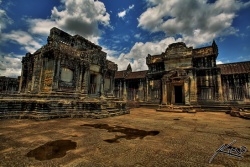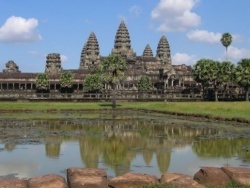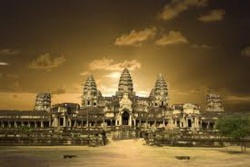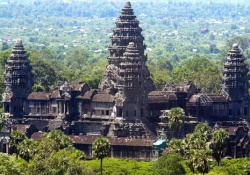Difference between revisions of "Angkor Wat (City Temple)"
(Created page with "thumb|250px| <poem> Angkor Wat ("City Temple") is a vast temple complex near Siem Reap, about 200 miles from the capital of Phnom Penh in Cambodia. Bu...") |
|||
| (6 intermediate revisions by 3 users not shown) | |||
| Line 1: | Line 1: | ||
[[File:Angkor-.jpg|thumb|250px|]] | [[File:Angkor-.jpg|thumb|250px|]] | ||
| − | |||
| − | |||
| − | |||
| − | |||
| − | |||
| − | |||
| − | |||
| − | |||
| − | |||
| − | Angkor Wat | + | [[Angkor Wat]] ("City [[Temple]]") is a vast [[temple]] complex near Siem Reap, about 200 {{Wiki|miles}} from the {{Wiki|capital}} of {{Wiki|Phnom Penh}} in [[Cambodia]]. Built in the 12th century by the [[king]] of the [[prosperous]] {{Wiki|Khmer}} [[empire]], [[Angkor Wat]] was built as a {{Wiki|royal}} [[temple]] dedicated to a [[Hindu]] [[Deity]]. |
| − | |||
| − | During its six centuries as imperial capital, Angkor went through many changes in architectural styles and in | + | After the city of [[Angkor]] fell to invaders, [[Angkor Wat]] receded into the jungle but continued as a [[Buddhist]] [[temple]] and a [[Pilgrimage]] site over the centuries. |
| + | |||
| + | |||
| + | [[Angkor Wat]] is the best preserved example of {{Wiki|Khmer}} [[architecture]] in [[Cambodia]] and is so grand in design that some rank it among the seven wonders of the [[World]]. It appears on the [[Cambodian]] [[national flag]], a very rare instance of [[A flag]] incorporating an {{Wiki|image}} of a building. | ||
| + | |||
| + | The "lost city" of [[Angkor]] first attracted the [[Interest]] of {{Wiki|Europeans}} in the 1800s after [[Cambodia]] was colonized by the {{Wiki|French}}. Today, [[Angkor Wat]] continues to draw thousands of visitors anxious to see this remarkable {{Wiki|ancient}} [[temple]] in the jungle. | ||
| + | |||
| + | |||
| + | In addition to many tourists, [[Buddhist]] [[Monks]] are daily visitors to [[Angkor Wat]], their bright orange [[Robes]] making a vivid contrast with the grey stone of the [[temple]]. | ||
| + | |||
| + | |||
| + | === {{Wiki|History}} === | ||
| + | |||
| + | |||
| + | The city of [[Angkor]] was the {{Wiki|capital}} of the {{Wiki|Khmer}} [[Empire]] from the 9th to the 15th centuries. The {{Wiki|Khmer}} [[empire]] was one of the most [[prosperous]] and sophisticated {{Wiki|kingdoms}} in the {{Wiki|history}} of {{Wiki|Southeast Asia}}, and its {{Wiki|prosperity}} was expressed through a wide range of [[architecture]]. | ||
| + | |||
| + | |||
| + | The city of [[Angkor]] was founded on {{Wiki|political}} and [[religious]] [[ideas]] adapted from [[India]], and the [[temples]] of [[Angkor]] were intended as a place of {{Wiki|worship}} for the [[king]] and a [[Way]] for him to ensure his [[immortality]] through {{Wiki|identification}} with the [[Hindu]] [[Gods]]. | ||
| + | |||
| + | [[Angkor Wat]] was built by [[King]] [[Wikipedia:Suryavarman II |Suryavarman]] II in the 12th century as a vast funerary [[temple]] that would hold his {{Wiki|remains}}, [[symbolically]] confirming his [[permanent]] [[identity]] with [[Vishnu]]. | ||
| + | |||
| + | |||
| + | |||
| + | Many of the bas-reliefs in the [[temple]] depict scenes from the {{Wiki|Ramayana}} and {{Wiki|Mahabharata}}, [[Hindu]] [[Sacred Texts]] that recount the adventures of two major [[incarnations]] of [[Vishnu]]. | ||
| + | |||
| + | |||
| + | |||
| + | During its six centuries as {{Wiki|imperial}} {{Wiki|capital}}, [[Angkor]] went through many changes in architectural styles and in [[Religion]]. The city of [[Angkor]] transferred its from the [[Hindu]] [[God]] [[Shiva]] to the [[Hindu]] [[God]] [[Vishnu]], and finally to the [[Mahayana]] [[Buddhist]] [[Deity]] [[Avalokitesvara]]. | ||
[[File:78701.jpg|thumb|250px|]] | [[File:78701.jpg|thumb|250px|]] | ||
| − | |||
| − | At the same | + | By the late 13th century, the once frenzied pace of [[Angkor]]'s architectural pursuits had begun to [[die]] down, and a more restrained type of [[Religion]] was on the rise under the growing [[influence]] of [[Theravada]] [[Buddhism]]. |
| + | |||
| + | At the same [[Time]], [[Angkor]] and the {{Wiki|Khmer}} [[Empire]] were increasingly threatened and attacked by invading armies. By the 16th century, the golden age of [[Angkor]] was over and many of the great [[temples]] began to recede into the jungle. | ||
| + | |||
| + | |||
| + | From the 15th to 19th centuries, [[Theravada]] [[Buddhist]] [[Monks]] cared for [[Angkor Wat]], and it is thanks to them that the [[temple]] {{Wiki|remains}} mostly intact. [[Angkor Wat]] became one of the most important [[Pilgrimage]] sites in {{Wiki|Southeast Asia}}. | ||
| − | + | {{Wiki|European}} visitors to [[Cambodia]] towards the later end of this period were intrigued by the "lost city" of [[Angkor]]. After the {{Wiki|French}} established a colonial regime in [[Cambodia]] in 1863, the entire site became a focus of [[scholarly]] [[Interest]]. | |
| − | |||
| + | [[Angkor]]'s [[temple]] [[architecture]] was heavily influenced by [[Indian]] [[ideas]]. From the earliest days of the city, [[Angkor]] had been [[conceived]] as a [[symbolic]] [[Universe]] structured according to [[Hindu cosmology]]. The city was accordingly built around a {{Wiki|central}} [[temple]] on a [[hill]], which [[symbolized]] [[Mount Meru]], the home of the [[Gods]]. | ||
| − | |||
| − | The central tower of each temple also represented Mount Meru. The outer walls of the temple represented the mountains that were believed to encircle the cosmos. | + | The {{Wiki|central}} tower of each [[temple]] also represented [[Mount Meru]]. The outer walls of the [[temple]] represented the [[mountains]] that were believed to encircle the [[cosmos]]. |
| − | The many waterways, canals and moats of Angkor served a dual purpose: they symbolized the waters of the cosmos and improved water control and rice irrigation. | + | The many waterways, canals and moats of [[Angkor]] served a dual [[purpose]]: they [[symbolized]] the waters of the [[cosmos]] and improved [[water]] control and {{Wiki|rice}} irrigation. |
| − | Angkor Wat consists of five central shrines, encircled by a moat and three galleries. On the west side of the complex a paved causeway, leading over the moat and under a magnificent portico, extends for a distance of a quarter of a mile to the chief entrance of the main building. | + | [[Angkor Wat]] consists of five {{Wiki|central}} [[shrines]], encircled by a moat and three galleries. On the {{Wiki|west}} side of the complex a paved causeway, leading over the moat and under a magnificent portico, extends for a distance of a quarter of a mile to the chief entrance of the main building. |
[[File:Ima-65.jpg|thumb|250px|]] | [[File:Ima-65.jpg|thumb|250px|]] | ||
| − | |||
| − | |||
| − | The third gallery encloses the five shrines which are built on a raised terrace and are interconnected by galleries. The roofings of the galleries are decorated with the motif of the | + | The first gallery has square pillars on the outer side and a closed wall on the inner side. The ceiling between the pillars is decorated with [[Lotus]] rosettes; the closed wall is decorated with [[Dancing]] figures. The outside of the inner wall is decorated with pillared windows, [[apsaras]] ([[heavenly]] [[nymphs]]), and [[Dancing]] {{Wiki|male}} figures on prancing [[Animals]]. [[Apsaras]] are found on the walls of all galleries. |
| + | |||
| + | From the first gallery a long avenue leads to the second gallery. This is reached via a raised platform with [[lions]] on both sides of a staircase. The inner walls of the second gallery contain continuous {{Wiki|narrative}} relief. The [[western]] wall shows scenes from the {{Wiki|Mahabharata}} epos. | ||
| + | |||
| + | |||
| + | The third gallery encloses the five [[shrines]] which are built on a raised terrace and are interconnected by galleries. The roofings of the galleries are decorated with the motif of the [[Body]] of a {{Wiki|snake}} ending in the heads of [[lions]] or [[garudas]]. Sculptured lintels and frontons decorate the entrances to the galleries and the entrances to the [[shrines]]. | ||
| + | |||
| + | The five {{Wiki|central}} [[shrines]] have three levels, connected by numerous exterior staircases and {{Wiki|decreasing}} in {{Wiki|dimensions}} as they go up. The [[temple]] culminates in the [[Sanctuary]], a great {{Wiki|central}} tower pyramidal in [[Form]]. Towers also surmount the angles of the terraces of the two upper stages. | ||
| + | |||
| + | |||
| + | |||
| + | Three galleries with vaulting supported on columns lead from the three [[western]] portals to the second stage. They are connected by a transverse gallery, thus forming four square basins. | ||
| + | |||
| + | The [[western]] exterior forecourt of the main [[temple]] contains two "libraries," or smaller [[temple]] structures. As of 2004, the library on the left was under renovation by a [[Japanese]] {{Wiki|archeological}} team.The area surrounding the exterior moat is a lawned park, incongruous in [[Cambodia]]. | ||
| − | |||
| − | + | {{Wiki|Khmer}} decoration, profuse but harmonious, consists chiefly in the [[representation]] of [[Gods]], men and [[Animals]], which are displayed on every flat surface. Combats and legendary episodes are often depicted; floral decoration is reserved chiefly for borders, mouldings and capitals. | |
| − | |||
| − | |||
[[File:Angkor-wat-temple.jpg|thumb|250px|]] | [[File:Angkor-wat-temple.jpg|thumb|250px|]] | ||
| − | Sandstone of various colours was the chief material employed by the Khmers; limonite was also used. The stone was cut into huge blocks which are fitted together with great accuracy without the use of cement. | + | Sandstone of various colours was the chief {{Wiki|material}} employed by the [[Wikipedia:Khmer people|Khmers]]; limonite was also used. The stone was cut into huge blocks which are fitted together with great accuracy without the use of cement. |
| + | |||
| + | |||
| + | Visitors to [[Angkor Wat]] take away varied [[impressions]] of these amazing [[temples]]. Some gain [[Insight]] into [[Buddhism]] or archaeology, and some relate their [[experience]] as connecting with the [[Spiritual]] [[energy]] of the [[temples]]. The one common thread, though, is the visitors' [[impressions]] of sunrise and sunset. | ||
| + | |||
| + | The skies over [[Angkor]] always put on a show; if you [[Time]] it Right, you can see the dawn or the day's afterglow framed in [[temple]] spires or glowing off the main [[Wat]]. Here are a few hints for catching the [[magic]] hours at the [[temples]]: | ||
| + | |||
| − | |||
| − | |||
| − | |||
{{R}} | {{R}} | ||
[http://www.sacred-destinations.com/cambodia/angkor-wat www.sacred-destinations.com] | [http://www.sacred-destinations.com/cambodia/angkor-wat www.sacred-destinations.com] | ||
[[Category:Cambodia]] | [[Category:Cambodia]] | ||
[[Category:Angkor Wat]] | [[Category:Angkor Wat]] | ||
| + | [[Category:Buddhist Terms]] | ||
Latest revision as of 06:39, 12 April 2024
Angkor Wat ("City Temple") is a vast temple complex near Siem Reap, about 200 miles from the capital of Phnom Penh in Cambodia. Built in the 12th century by the king of the prosperous Khmer empire, Angkor Wat was built as a royal temple dedicated to a Hindu Deity.
After the city of Angkor fell to invaders, Angkor Wat receded into the jungle but continued as a Buddhist temple and a Pilgrimage site over the centuries.
Angkor Wat is the best preserved example of Khmer architecture in Cambodia and is so grand in design that some rank it among the seven wonders of the World. It appears on the Cambodian national flag, a very rare instance of A flag incorporating an image of a building.
The "lost city" of Angkor first attracted the Interest of Europeans in the 1800s after Cambodia was colonized by the French. Today, Angkor Wat continues to draw thousands of visitors anxious to see this remarkable ancient temple in the jungle.
In addition to many tourists, Buddhist Monks are daily visitors to Angkor Wat, their bright orange Robes making a vivid contrast with the grey stone of the temple.
History
The city of Angkor was the capital of the Khmer Empire from the 9th to the 15th centuries. The Khmer empire was one of the most prosperous and sophisticated kingdoms in the history of Southeast Asia, and its prosperity was expressed through a wide range of architecture.
The city of Angkor was founded on political and religious ideas adapted from India, and the temples of Angkor were intended as a place of worship for the king and a Way for him to ensure his immortality through identification with the Hindu Gods.
Angkor Wat was built by King Suryavarman II in the 12th century as a vast funerary temple that would hold his remains, symbolically confirming his permanent identity with Vishnu.
Many of the bas-reliefs in the temple depict scenes from the Ramayana and Mahabharata, Hindu Sacred Texts that recount the adventures of two major incarnations of Vishnu.
During its six centuries as imperial capital, Angkor went through many changes in architectural styles and in Religion. The city of Angkor transferred its from the Hindu God Shiva to the Hindu God Vishnu, and finally to the Mahayana Buddhist Deity Avalokitesvara.
By the late 13th century, the once frenzied pace of Angkor's architectural pursuits had begun to die down, and a more restrained type of Religion was on the rise under the growing influence of Theravada Buddhism.
At the same Time, Angkor and the Khmer Empire were increasingly threatened and attacked by invading armies. By the 16th century, the golden age of Angkor was over and many of the great temples began to recede into the jungle.
From the 15th to 19th centuries, Theravada Buddhist Monks cared for Angkor Wat, and it is thanks to them that the temple remains mostly intact. Angkor Wat became one of the most important Pilgrimage sites in Southeast Asia.
European visitors to Cambodia towards the later end of this period were intrigued by the "lost city" of Angkor. After the French established a colonial regime in Cambodia in 1863, the entire site became a focus of scholarly Interest.
Angkor's temple architecture was heavily influenced by Indian ideas. From the earliest days of the city, Angkor had been conceived as a symbolic Universe structured according to Hindu cosmology. The city was accordingly built around a central temple on a hill, which symbolized Mount Meru, the home of the Gods.
The central tower of each temple also represented Mount Meru. The outer walls of the temple represented the mountains that were believed to encircle the cosmos.
The many waterways, canals and moats of Angkor served a dual purpose: they symbolized the waters of the cosmos and improved water control and rice irrigation.
Angkor Wat consists of five central shrines, encircled by a moat and three galleries. On the west side of the complex a paved causeway, leading over the moat and under a magnificent portico, extends for a distance of a quarter of a mile to the chief entrance of the main building.
The first gallery has square pillars on the outer side and a closed wall on the inner side. The ceiling between the pillars is decorated with Lotus rosettes; the closed wall is decorated with Dancing figures. The outside of the inner wall is decorated with pillared windows, apsaras (heavenly nymphs), and Dancing male figures on prancing Animals. Apsaras are found on the walls of all galleries.
From the first gallery a long avenue leads to the second gallery. This is reached via a raised platform with lions on both sides of a staircase. The inner walls of the second gallery contain continuous narrative relief. The western wall shows scenes from the Mahabharata epos.
The third gallery encloses the five shrines which are built on a raised terrace and are interconnected by galleries. The roofings of the galleries are decorated with the motif of the Body of a snake ending in the heads of lions or garudas. Sculptured lintels and frontons decorate the entrances to the galleries and the entrances to the shrines.
The five central shrines have three levels, connected by numerous exterior staircases and decreasing in dimensions as they go up. The temple culminates in the Sanctuary, a great central tower pyramidal in Form. Towers also surmount the angles of the terraces of the two upper stages.
Three galleries with vaulting supported on columns lead from the three western portals to the second stage. They are connected by a transverse gallery, thus forming four square basins.
The western exterior forecourt of the main temple contains two "libraries," or smaller temple structures. As of 2004, the library on the left was under renovation by a Japanese archeological team.The area surrounding the exterior moat is a lawned park, incongruous in Cambodia.
Khmer decoration, profuse but harmonious, consists chiefly in the representation of Gods, men and Animals, which are displayed on every flat surface. Combats and legendary episodes are often depicted; floral decoration is reserved chiefly for borders, mouldings and capitals.
Sandstone of various colours was the chief material employed by the Khmers; limonite was also used. The stone was cut into huge blocks which are fitted together with great accuracy without the use of cement.
Visitors to Angkor Wat take away varied impressions of these amazing temples. Some gain Insight into Buddhism or archaeology, and some relate their experience as connecting with the Spiritual energy of the temples. The one common thread, though, is the visitors' impressions of sunrise and sunset.
The skies over Angkor always put on a show; if you Time it Right, you can see the dawn or the day's afterglow framed in temple spires or glowing off the main Wat. Here are a few hints for catching the magic hours at the temples:



